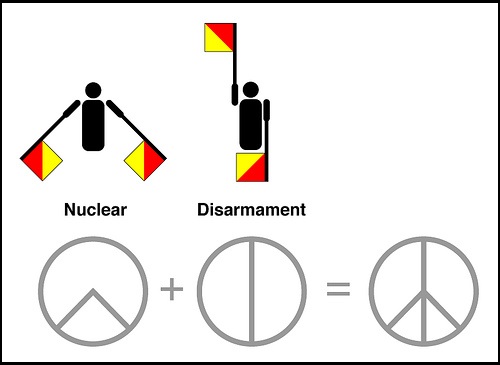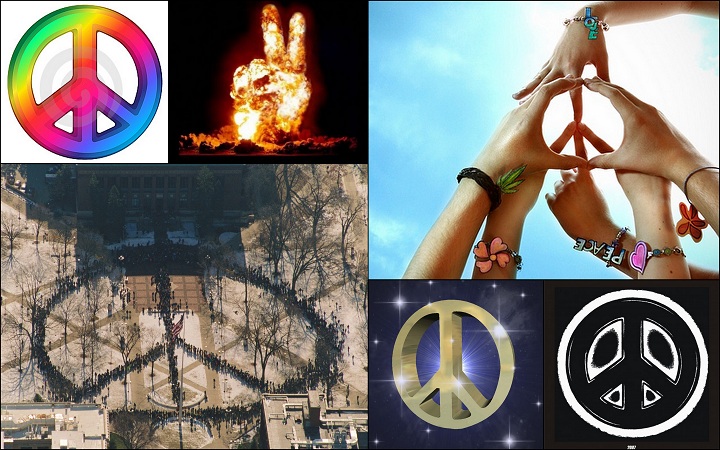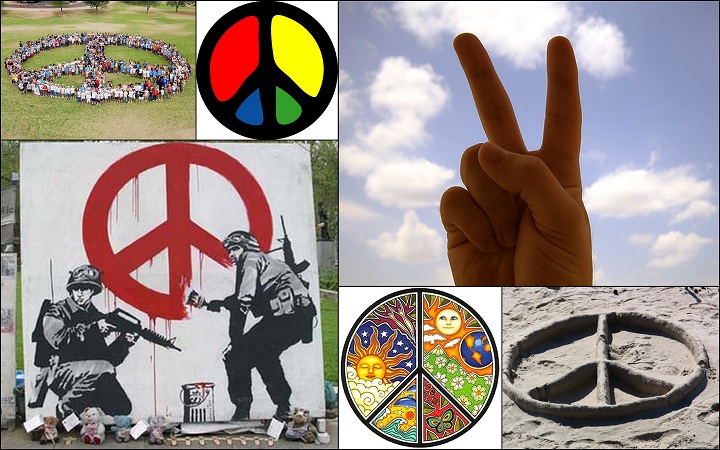 One of the most widely known symbols in the world, in Britain it is recognised as standing for nuclear disarmament —and in particular as the logo of the Campaign for Nuclear Disarmament (CND). It was designed from the naval code of semaphore, and the symbol represents the code letters for ND which means Nuclear Disarmament.The circle, representing the concept of total or complete, surrounds the N and D signifying total or complete nuclear disarmament.
One of the most widely known symbols in the world, in Britain it is recognised as standing for nuclear disarmament —and in particular as the logo of the Campaign for Nuclear Disarmament (CND). It was designed from the naval code of semaphore, and the symbol represents the code letters for ND which means Nuclear Disarmament.The circle, representing the concept of total or complete, surrounds the N and D signifying total or complete nuclear disarmament.In the United States and much of the rest of the world it is known more broadly as the peace symbol. It was designed in 1958 by Gerald Holtom, a professional designer and artist and a graduate of the Royal College of Arts. He showed his preliminary sketches to a small group of people in the Peace News office in North London and to the Direct Action Committee Against Nuclear War, one of several smaller organisations that came together to set up CND.
The Direct Action Committee had already planned what was to be the first major anti-nuclear march, from London to Aldermaston, where British nuclear weapons were and still are manufactured. It was on that march, over the 1958 Easter weekend that the symbol first appeared in public. Five hundred cardboard lollipops on sticks were produced. Half were black on white and half white on green. Just as the church’s liturgical colours change over Easter, so the colours were to change, “from Winter to Spring, from Death to Life.” Black and white would be displayed on Good Friday and Saturday, green and white on Easter Sunday and Monday.

The first badges were made by Eric Austin of Kensington CND using white clay with the symbol painted black. Again there was a conscious symbolism. They were distributed with a note explaining that in the event of a nuclear war, these fired pottery badges would be among the few human artifacts to survive the nuclear inferno. These early ceramic badges can still be found and one, lent by CND, was included in the Imperial War Museum’s 1999/2000 exhibition ”From the Bomb to the Beatles”.

Later, in a letter, Holtom also admitted that the symbol reflected his mood at the time. “I was in despair,” he wrote. “Deep despair. I drew myself: the representative of an individual in despair, with hands palm outstretched outwards and downwards in the manner of Goya’s peasant before the firing squad. I formalized the drawing into a line and put a circle around it.”
American journalist and playwright Herb Greer adds support for the Holtom explanation. He reported, “I was actually there on and before the first Aldermaston march for which it was created. I visited Holtom, I saw the original sketches and discussed it with him.”
Ken Kolsbun, author of the book Peace: The Biography of a Symbol, reported that Holtom expressed regret in not designing the peace symbol with the joyful lifting of arms towards the sky. For most of Holtom’s life he would draw only the upright peace symbol. Holtom requested that the upright peace symbol be placed on his tombstone in Kent, England. If we take a look on the picture of his tombstone, we’ll see that his wish was unfortunately ignored.
While it appears reasonable that the modern day peace symbol comes from Gerald Holtom, this logic fails to address the fact that the symbol has been used for evil both in modern times and for thousands of years.
This same symbol was used by Hitler’s 3rd Panzer Division from 1941 to 1945. The image on the left is the regimental 3rd Panzer Division symbol. Soviet, Polish, and Hungarian citizens, having suffered from the Nazi massacres, undoubtedly struggled with Holtom’s use of the symbol as a thoughtful way to communicate peace. The symbol can also be found on some of Hitler’s SS soldiers’ tombstones.
Another flaw in the Holtom creation story is the use of the symbol as an anti-Christian symbol by the Saracens as early as 711 A.D.For the Saracens, the image placed on their shields symbolized the breaking of the Christian cross. For some the broken cross was equated to a satanic symbol known as the raven’s craw or witch’s foot. While Holtom may not have known the historical meaning of the peace symbol, Bertrand Russell was a historian and member of the Fabian Society. A 1970 article in the American Opinion magazine claimed Russell knew the historical occult meaning and intentionally selected an “anti-Christian design long associated with Satanism.”

The fifth and final Roman emperor of the Julio-Claudian dynasty, Nero (born Lucius Domitius Ahenabarbus 37 – 68 AD), is remembered in history for persecuting Christians. Nero’s rule was so wicked he even had his mother executed. The First Roman-Jewish War (66 – 70 AD) started during his reign and today the term “Nero Cross” is the symbol of the “broken Jew” or “broken cross.” The most famous person believed to be crucified by Nero was the Apostle Peter. To symbolize humility and unworthiness in comparison to Christ, Peter requested that he be crucified with his head toward the ground. As a result of Peter’s death the upside down cross was used by early Christians as a positive symbol for peace.
The symbol of the upside down cross changes its meaning when the person on the upside down cross is no longer Peter but Jesus. Anti-religious and satanic groups use the “Nero Cross” or inverted “Latin Cross” to symbolize everything opposite of Christianity. Today this is clearly illustrated by “black metal” or heavy metal music lyrics and imagery that communicate anti-Christian sentiments. In addition to musicians, film makers have reinforced the notion that the upside down cross is an anti-Christian symbol as illustrated by The Omen in 1976 and The Exorcism of Emily Rose in 2005.
The symbol has also been used to communicate support for communism. Bertrand Russell once said: “There is no hope in anything but the Soviet way.” Governments–both those who supported communism and those opposed to it–have perceived benefits in aligning the peace symbol with communist ideology. For people like Bertrand Russell, the author of the 1927 essay Why I Am Not Christian, the symbol represented not only a pro-communism meaning but peace without God.
CND has never registered the sign as a trademark, arguing that “a symbol of freedom, it is free for all”. It has now appeared on millions of mugs, T-shirts, rings and nose-studs. Bizarrely, it has also made an appearance on packets of Lucky Strike cigarettes.A decade ago, the sign was chosen during a public vote to appear on a US commemorative postage stamp saluting the 1960s.The symbol that helped define a generation of baby boomers may not be as widely used today as in the past. It is in danger of becoming to many people a retro fashion item, although the Iraq war has seen it re-emerge with something like its original purpose.
“Today because many people carry the symbol without understanding the history, we miss an opportunity to address historical uses and move forward to reclaim the symbol for good.When you see the peace symbol, I encourage you to see the person displaying it as communicating a message of love.If you display the peace symbol, my recommendation is point the arms of the peace symbol toward the sky to honor Holtom’s wish, address historical objections, and communicate love of all people.”Dave Dionisi, Teach Peace Foundation"
sumber: Google, wiki, googlearchive

